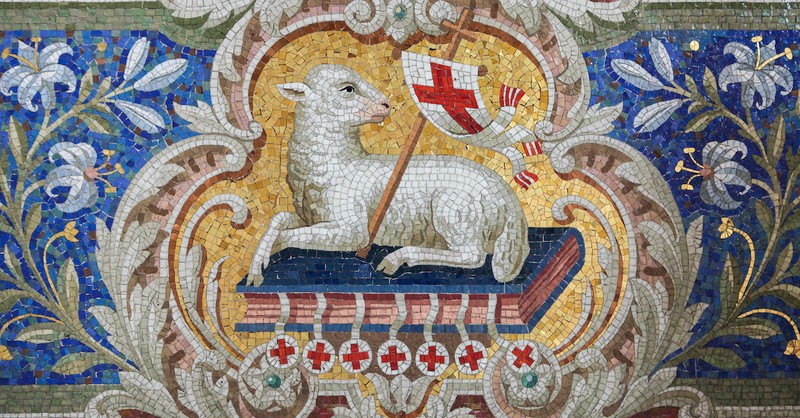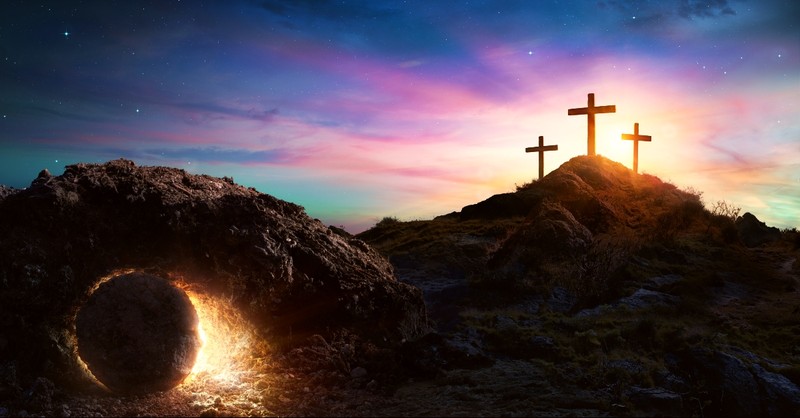
There’s something so poignant about opening up the Old Testament and discovering allusions to Jesus’ death and resurrection. It’s a comforting reminder that humankind’s salvation had been in the works long before Jesus’ coming—and that it was all part of God’s eternal plan.
As you read the seven passages below, I hope you will realize that Jesus was always there—and that He’s always been there with you. When the Hebrews were slaves in Egypt, He was there. When they were sent as captives to Babylon, He was there. And when the prophets of old were dipping their styluses in their inkwells, envisioning the arrival of a fierce and mighty Messiah who would liberate Israel, He was there—standing over their shoulders and inspiring their every word.
Come along with me as I delve into some of those ancient texts and discover the omnipresence of Jesus. From the very beginning, Jesus has been with us—His constant presence pointing to His saving work on the cross and His victory over the grave.
Photo Credit: ©Getty Images/Halfpoint
1. Job 19:25-27
"I know that my redeemer lives, and that in the end he will stand on the earth. And after my skin has been destroyed, yet in my flesh I will see God; I myself will see him with my own eyes—I, and not another. How my heart yearns within me!" (Job 19:25-27)
I know that my redeemer lives. This has to be one of the most comforting statements in the Bible. Hundreds of years before the resurrection of Jesus, Job was confident that the One who’d save him, his “redeemer,” was alive—and would be forever. Though Job has lost his fortune and family, he still believes in God, whom he is certain he will someday behold in all His glory with his very own eyes.
Job’s hope of resurrection is truly a beautiful one—and an enduring reminder that the glorious resurrection of Jesus was in God’s plan since the very beginning.
2. Ezekiel 37:4-6
Then he said to me, “Prophesy to these bones and say to them, ‘Dry bones, hear the word of the Lord! This is what the Sovereign Lord says to these bones: I will make breath enter you, and you will come to life. I will attach tendons to you and make flesh come upon you and cover you with skin; I will put breath in you, and you will come to life. Then you will know that I am the Lord.’” (Ezekiel 37:4-6)
In Ezekiel 37, God brings the prophet Ezekiel to a valley that is full of dry bones. The Lord then asks Ezekiel if the bones in the valley can live, and Ezekiel replies: “Lord, you alone know.” God consequently tells Ezekiel to prophesy over the bones and to command them to be restored to life. When Ezekiel complies, the bones miraculously fuse together, and flesh begins to cover them. This incredible moment is, without a doubt, a foretelling of Jesus’s glorious resurrection from the dead.

3. Isaiah 53:11-12
"After he has suffered, he will see the light of life and be satisfied; by his knowledge my righteous servant will justify many, and he will bear their iniquities. Therefore I will give him a portion among the great, and he will divide the spoils with the strong, because he poured out his life unto death, and was numbered with the transgressors. For he bore the sin of many, and made intercession for the transgressors." (Isaiah 53:11-12)
Isaiah 53 is perhaps one of the most poignant and beautiful passages in the Bible—and makes for a perfect Good Friday reading. In chapter 53, Isaiah paints the picture of “a man of suffering” who “took up our pain and bore our suffering” (Isaiah 53:3-4). I am sure you know—and love!—this touching verse: “But he was pierced for our transgressions, he was crushed for our iniquities; the punishment that brought us peace was on him, and by his wounds we are healed” (Isaiah 53:5).
Christian theologians agree Isaiah’s so-called “Suffering Servant” and Jesus are one and the same. According to Isaiah—just like Jesus, who did not speak in His defense during His trial—the Suffering Servant “was oppressed and afflicted, yet he did not open his mouth; he was led like a lamb to the slaughter, and as a sheep before its shearers is silent, so he did not open his mouth. By oppression and judgment he was taken away” (Isaiah 53:7).
Furthermore, in verse 9, Isaiah prophesies of Jesus’s death beside two criminals (“He was assigned a grave with the wicked”) and His burial in Joseph of Arimathea’s tomb (“He was assigned a grave…with the rich in his death, though he had done no violence, nor was any deceit in his mouth.”).
Isaiah ultimately foreshadows Jesus’s miraculous resurrection in the passage I have quoted above. (“After he has suffered, he will see the light of life and be satisfied”), as well as His substitutionary atonement for humankind (“For he bore the sin of many, and made intercession for the transgressors.”)
Photo Credit: ©GettyImages/Jorisvo
4. Genesis 3:15
“And I will put enmity between you and the woman, and between your offspring and hers; he will crush your head, and you will strike his heel.” (Genesis 3:15)
After Adam and Eve commit the first act of disobedience, God curses them and their progeny, yet He gives them hope for humankind’s future redemption.
Theologians have interpreted this verse as the first ever prophecy of Jesus’s atoning death. In fact, in Christianity, Genesis 3:15 is known as the protoevangelium. This is a compound of two Greek words, protos meaning “first” and evangelion meaning “good news” or “gospel.” Put simply, Genesis 3:15 is the first place in Scripture where God hints at the good news of salvation.
As theologians explain, Jesus—who is the direct descendant of Eve (i.e. her “offspring”)—figuratively “crush[es]” the head of the serpent by dying on the cross at Calvary, meaning “Place of the Skull” in Latin. Furthermore, by enduring a full Roman crucifixion, Jesus—whose feet were nailed to the cross—undergoes just what God predicted would happen: “[The serpent] will strike his heel.”
Old Testament scholar Derek Kidner has described the protoevangelium as “the first glimmer of the gospel,” and Victor P. Hamilton has emphasized the importance of the redemptive promise included in the curse. Indeed, even when the Israelites disappoint and break their covenant with Him, God shows them mercy, promising that someday their very descendant will redeem them.
5. Hosea 13:14
“I will deliver this people from the power of the grave; I will redeem them from death. Where, O death, are your plagues? Where, O grave, is your destruction?” (Hosea 13:14)
Hundreds of years before the life of Jesus, God prophesies of the resurrection in Hosea. Though He is upset with Israel, He makes an amazing promise—He will deliver them “from the power of the grave” and “redeem them from death.” Afterwards, God questions death itself: “Where, O death, are your plagues? Where, O grave, is your destruction?” This is the very Scripture Paul boldly cites in 1 Corinthians 15:55-57 to defend the claims of Jesus’ resurrection: “‘Where, O death, is your victory? Where, O death, is your sting?’ The sting of death is sin, and the power of sin is the law. But thanks be to God! He gives us the victory through our Lord Jesus Christ.”

6. Isaiah 25:7-8
"On this mountain he will destroy the shroud that enfolds all peoples, the sheet that covers all nations; he will swallow up death forever. The Sovereign Lord will wipe away the tears from all faces; he will remove his people’s disgrace from all the earth. The Lord has spoken." (Isaiah 25:7-8)
In yet another verse from his eponymous book, Isaiah prophesies of the death of Jesus, predicting that God will defeat death on a mountain. As the Gospels later reveal, Jesus was crucified atop a hill—or mountain—called Calvary, literally “swallow[ing] up death forever” by taking death upon Himself.
Paul also quotes this verse in his First Letter to the Corinthians: “When the perishable has been clothed with the imperishable, and the mortal with immortality, then the saying that is written will come true: ‘Death has been swallowed up in victory’” (1 Corinthians 15:54).
7. Psalm 16:8-11
"I keep my eyes always on the Lord. With him at my right hand, I will not be shaken. Therefore my heart is glad and my tongue rejoices; my body also will rest secure, because you will not abandon me to the realm of the dead, nor will you let your faithful one see decay. You make known to me the path of life; you will fill me with joy in your presence, with eternal pleasures at your right hand." (Psalm 16:8-11)
In this moving passage, the Psalmist voices his trust in the Lord, who He is confident will deliver him from mortal danger. The Psalmist strongly believes that God will bless him with immortality, sparing him from the ravages of death.
In Acts 13:34-37, Paul cites Psalm 16:10 as a prophecy of Jesus’s resurrection. He writes, “God raised [Jesus] from the dead so that he will never be subject to decay … So it is also stated elsewhere: ‘You will not let your holy one see decay.’”
The resurrection was thus envisioned centuries before Jesus came to earth. God and His prophets had always been hinting at it, reminding the world that humankind’s salvation was close at hand.
Photo Credit: ©iStock/Getty Images Plus/RomoloTavani
Originally published Monday, 11 April 2022.









